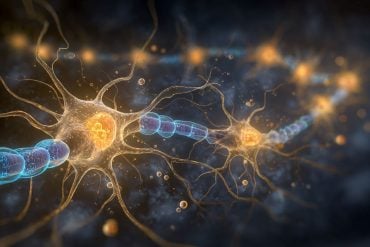Summary: Research reveals that the orbitofrontal cortex (OFC) and hippocampus (DH) play distinct roles in resolving ambiguous situations where the meaning of stimuli changes based on context. The OFC helps regulate behavior by using contextual knowledge, while the DH is critical for applying prior knowledge to accelerate learning new relationships.
Experiments with rats demonstrated that without a functional OFC, rats couldn’t adapt their reward-seeking behavior based on context, and without the DH, they struggled to learn new context-dependent tasks quickly. These findings provide deeper insight into how the brain builds a cognitive map to navigate complex, context-dependent decisions.
Key Facts:
- OFC Role: The orbitofrontal cortex enables context-based decision-making by regulating behavior based on learned associations.
- DH Function: The hippocampus facilitates rapid learning of new context-dependent relationships using prior knowledge.
- Cognitive Maps: Together, these brain regions construct mental maps that guide flexible, situation-appropriate actions.
Source: UC Santa Barbara
Life can be tricky. We have so many decisions to make. It’s a good thing we have an orbitofrontal cortex and hippocampus to help us.
These areas of the brain, according to researchers at UC Santa Barbara, work together to help us sort through tasks that require resolving ambiguity, that is, situations in which the meaning of stimuli changes depending on context.
“I would argue that that’s the foundation of cognition,” said UCSB neuroscientist Ron Keiflin, whose lab investigates the neural circuits behind valuation and decision-making.

“That’s what makes us not behave like simple robots, always responding in the same manner to every stimulus. Our ability to understand that the meaning of certain stimuli is context-dependent is what gives us flexibility; it is what allows us to act in a situation-appropriate manner.”
For instance, he said, your phone could be ringing, but whether you answer it will depend on a variety of factors, including where you are, what you’re doing, what time it is, who may be calling and other details.
It’s a single stimulus, Keiflin said, “but depending on the background circumstances, it’s going to be processed differently and you might decide to engage with it in a different manner.”
The research, published in the journal Current Biology, is the first to causally test the relative contributions of the orbitofrontal cortex and hippocampus in this contextual disambiguation process.
Making meaning
The orbitofrontal (OFC) occupies the front part of the brain right above the eyes. It’s associated with reward valuation, planning, decision-making and learning.
The dorsal hippocampus (DH) is located farther back, deeper into the brain, and it’s associated with spatial navigation and episodic memory.
“Historically, research on the orbitofrontal cortex and the hippocampus has proceeded largely in parallel, but ultimately these different lines of research reached very similar conclusions for these two brain regions,” Keiflin said.
“The idea is that these two brain regions encode a ‘cognitive map’ of the structure of the world,” he said, noting that it doesn’t have to be a purely spatial map.
“It’s a map of the causal structure of the environment; you can use this map to mentally simulate consequences of your actions and choose the best path forward.
This cognitive map is precisely what one needs to understand that the meaning of a cue depends on the context. But studies before this one hadn’t explicitly tested the role of these regions in contextual disambiguation.
To understand how these two regions contributed to contextual disambiguation, the researchers devised an experiment in which rats were exposed to brief auditory cues, presented in either a bright or a dark context (the context was changed by turning a light bulb on or off).
The auditory cues would sometimes lead to reward (a little bit of sugar water), but not always; other times the same cues would have no consequence, making them ambiguous predictors of rewards.
Eventually the rats would learn that one auditory cue was rewarded only in the light-, but not the dark- context; while the opposite was true for the other auditory cue. In other words, they would learn that the meaning of the cues was context-dependent.
The researchers knew when the rat had learned to discriminate between the two situations when the rats approached and licked the sugar water cup in anticipation of the reward in one setting, or not, in the other setting.
To determine how the orbitofrontal cortex and hippocampus were involved in this contextual disambiguation process, the researcher used “chemogenetics”— a tool that allowed them to temporarily inactivate either of these structures during the task.
They found that inactivation of the OFC had profound effects in the task. Without a functional OFC, rats were no longer able to use the context to inform their prediction and regulate their reward seeking behavior.
Surprisingly, DH was largely dispensable in this task; rats were completely unfazed by the inactivation of their hippocampus and they continued to perform the task with high accuracy.
Does this mean that the DH is not involved in contextual disambiguation? Not exactly. A key moment in their lab was when the researchers realized that knowledge is not only important for the recall of past learning, but also essential for future learning.
“If I walked into an advanced math lecture, I would understand — and learn — very little,” Keiflin said.
“But someone more mathematically knowledgeable would be able to understand the material, which would greatly facilitate learning.
Applied to our task, we thought that prior knowledge of context-dependent relationships would facilitate learning of new context-dependent relationships,” he continued. “And indeed, this is exactly what we observed.”
It took more than four months of training for rats to learn the initial context-dependent pairs, he said; however, once equipped with a cognitive map of context-dependent relationships, rats could learn new context-dependent relationships in just a few days.
Using the same chemogenetic approach, researchers examined the role of the OFC and DH is this knowledge-accelerated form of learning. This time, they found that both the OFC and the DH were essential.
Without these structures, rats could not use their prior knowledge to make inferences about new context-dependent relationships.
The conclusion is that the OFC and DH both contribute to contextual disambiguation, but in partially different ways: OFC is essential for using contextual knowledge to regulate behavior, DH on the other hand is more important for using contextual knowledge to facilitate new contextual learning.
The fact that prior knowledge influences learning is well established in psychology and well known by educators, however it is often ignored in neuroscience research, Keflin pointed out.
“A better neurobiological understanding of this rapid learning and inference of context-dependent relations is critical, as this form of learning is probably much more representative of the human learning experience.”
About this decision-making and neuroscience research news
Author: Daniel Smith
Source: UC Santa Barbara
Contact: Daniel Smith – UC Santa Barbara
Image: The image is credited to Neuroscience News
Original Research: Open access.
“Partially dissociable roles of the orbitofrontal cortex and dorsal hippocampus in context-dependent hierarchical associations” by Ron Keiflin et al. Current Biology
Abstract
Partially dissociable roles of the orbitofrontal cortex and dorsal hippocampus in context-dependent hierarchical associations
Reward cues are often ambiguous; what is good in one context is not necessarily good in another. To solve this ambiguity, animals form hierarchical associations in which the context gates the retrieval of appropriate cue-evoked memories.
These hierarchical associations regulate cue-elicited behavior and influence subsequent learning, promoting the inference of context-dependency.
The orbitofrontal cortex (OFC) and dorsal hippocampus (DH) are both proposed to encode a “cognitive map” encompassing hierarchical, context-dependent associations.
However, OFC- and DH-specific contributions to the different functional properties of hierarchical associations remain controversial.
Using chemogenetic inactivation in rats, we show that the OFC is essential to both properties of hierarchical associations (performance regulation and learning bias). In contrast, DH’s role appears limited to the contextual learning bias conferred by hierarchical associations.
This work establishes the OFC as a critical orchestrator of hierarchical associations and provides insights into the extended circuits mediating the functional properties of these associations.






